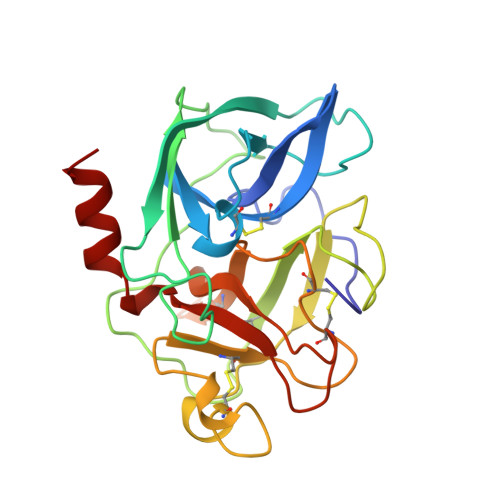Mechanistic insights into the inhibition of serine proteases by monocyclic lactams.
Wilmouth, R.C., Kassamally, S., Westwood, N.J., Sheppard, R.J., Claridge, T.D., Aplin, R.T., Wright, P.A., Pritchard, G.J., Schofield, C.J.(1999) Biochemistry 38: 7989-7998
- PubMed: 10387042
- DOI: https://doi.org/10.1021/bi990098y
- Primary Citation of Related Structures:
1QGF - PubMed Abstract:
Although originally discovered as inhibitors of pencillin-binding proteins, beta-lactams have more recently found utility as serine protease inhibitors. Indeed through their ability to react irreversibly with nucleophilic serine residues they have proved extraordinarily successful as enzyme inhibitors. Consequently there has been much speculation as to the reason for the general effectiveness of beta-lactams as antibacterials or inhibitors of hydrolytic enzymes. The interaction of analogous beta- and gamma-lactams with a serine protease was investigated. Three series of gamma-lactams based upon monocyclic beta-lactam inhibitors of elastase [Firestone, R. A. et al. (1990) Tetrahedron 46, 2255-2262.] but with an extra methylene group inserted between three of the bonds in the ring were synthesized. Their interaction with porcine pancreatic elastase and their efficacy as inhibitors were evaluated through the use of kinetic, NMR, mass spectrometric, and X-ray crystallographic analyses. The first series, with the methylene group inserted between C-3 and C-4 of the beta-lactam template, were readily hydrolyzed but were inactive or very weakly active as inhibitors. The second series, with the methylene group between C-4 and the nitrogen of the beta-lactam template, were inhibitory and reacted reversibly with PPE to form acyl-enzyme complexes, which were stable with respect to hydrolysis. The third series, with the methylene group inserted between C-2 and C-3, were not hydrolyzed and were not inhibitors consistent with lack of binding to PPE. Comparison of the crystal structure of the acyl-enzyme complex formed between PPE and a second series gamma-lactam and that formed between PPE and a peptide [Wilmouth, R. C., et al. (1997) Nat. Struct. Biol. 4, 456-462.] reveals why the complexes formed with this series were resistant to hydrolysis and suggests ways in which stable acyl-enzyme complexes might be obtained from monocyclic gamma-lactam-based inhibitors.
Organizational Affiliation:
The Oxford Centre for Molecular Sciences, The Dyson Perrins Laboratory, United Kingdom.

















